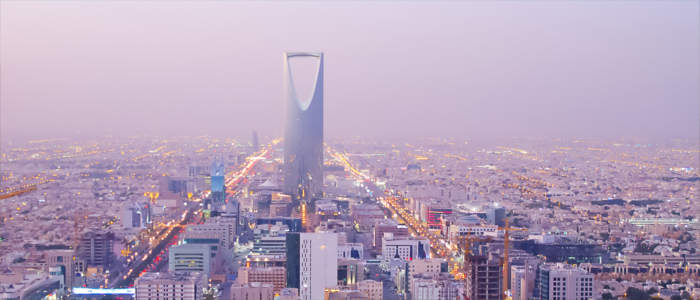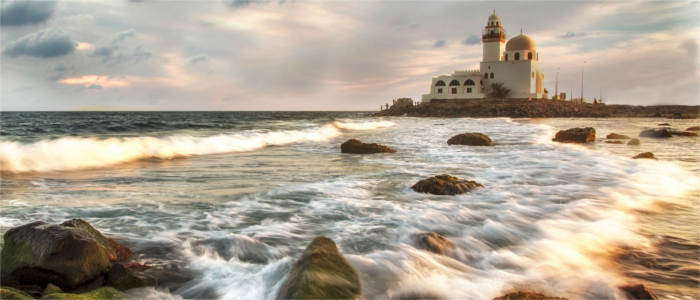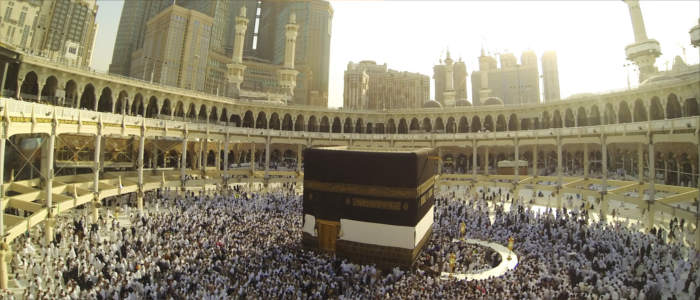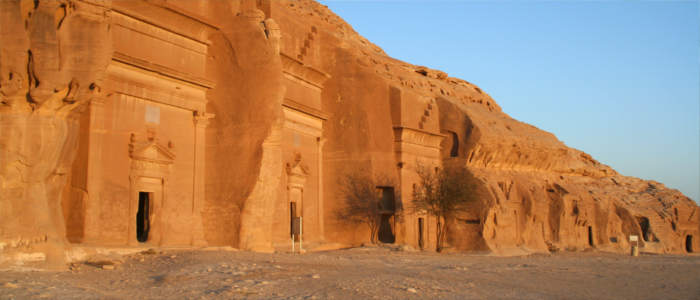Travel Offers
Travelmyne Featureprint
Distance
Current notice: Individual tourists are not allowed visas and foreign tourism is generally severely limited. Occassionally, travel groups with guides from western countries are allowed into the country.
Saudi Arabia - The Forbidden Desert State
An endless sea of yellow sand, the heat of the red-hot sun and a green shimmer in the distance - the oases of the desert are the birthplace of the world's greatest desert metropolises. Futuristic skyscrapers now watch over Saudi Arabia.

Geography - The heat of the Arabian Peninsula
Saudi Arabia is a storybook desert state and takes up the major part of the Arabian Peninsula. It cannot be considered a tourist country because foreign tourism is severely limited. The country borders on Iraq, Jordan, Kuwait and Qatar as well on Oman, Yemen and the United Arab Emirates. It is divided into 13 provinces, in addition to two neutral regions. Most people live in the four big cities of Riyadh, Jeddah, Mecca and Medina. The latter two are inaccessible to non-Muslims. Saudi Arabia is one of the hottest and driest countries on earth. Even during the colder season, the average temperature is 25 °C. In the summer months from April to November, it is 30 to 40 °C. In the hot desert region, temperatures are up to 50 or even 60 °C, while they near freezing point at night.

Nature - In the land of the sand dunes
Deserts and dry steppes characterise the scenery. The Nefud almost seems small with its area of 78,000 km² in comparison to the Rub' al Khali, which is the greatest sandy desert on earth. It comprises 780,000 km² and takes up the southern third of the Arabian Peninsula. Its sand dunes of 300 metres of height threaten whole cities as they expand more and more. Occasionally, you find fertile oases with little springs of water and date trees in the desert zones. Some of these were the origin of towns or whole cities. The only forests are located in the coastal areas. Cedars and holly oaks brave the inhospitable climate. In addition, Aloe was also able to flourish in the desert country. Almost 200 species, including Aloe vera, grow in Saudi Arabia. There are no grate lakes in the desert state but a number of salt lakes and wadis. Gazelles and Arabian wolves populate the milder latitudes and if you are very lucky, you may spot a leopard.

Natural sights - Sand, rocks and oases
The sandstone formations of Jabal al-Qara in Al-Hasa or the rocks near the capital of Riyadh look like a strange moon landscape to foreign eyes. You see such formations all over the rocky and sandy deserts. The true highlight of every desert are, of course, the oases. They have been the last resort for people who had been lost in the heat of the desert many times. Nowadays the oases are used for the cultivation of plants like dates, rice and vegetables. The only garden is located in Salam Park in Riyadh. Lush ferns and green palms grow on this area. The park's centrepiece is its lake, which has an area of 33,000 m².

Culture - According to the rules of the Quran
Saudi Arabia has a special status regarding religion and culture. The two most important cultural sites of the Muslims are located in the desert state and there is no other country which follows the customs according to the Quran and the Sharia as strictly as Saudi Arabia. The monarchy contributes to this and places value on a role model function in the world. Besides religion, the oil boom had great influence on the life and work in the country. Until the 1950s, the country was among the poorest ones on earth. Today it has one of the most highly developed infrastructures and invests in education and economy. Furthermore, Saudi Arabia is the greatest crude oil exporter worldwide and this wealth is reflected in the country's city architecture and modern skyscrapers. However, the inhabitants still adhere to the Quran and their beliefs. There is a strict dress code for both men and women and travellers have to dress appropriately without revealing too much skin - even in extreme temperatures.

Cultural sights - Mecca, Medina and Jeddah
A great number of the Muslims' important sacred sites are located in Saudi Arabia. Among them you find the most significant place of prayer, the Kaaba in Mecca. All over the world Muslims pray towards Mecca. The Kaaba is its centre and the most important pilgrimage destination. However, it can not be accessed by non-Muslims. This prohibition also applies to the second sacred site, the burial place of the prophet Muhammad in Medina. Countless Muslims from all over the world pilgrimage to this place every year. They usually also visit the holy Zamzam Well, the valley of Mina and Mount Arafat ("Mount of Mercy"). The UNESCO declared the 2,000-year-old site Mada'in Saleh near Medina a World Cultural Heritage site in 2008. Its tombs as well as the inscriptions and mural paintings are over 200 years old. Riyadh has only been the country's capital since 1932. Its name means as much as "the gardens", which is a reference to the history of the city, which was once an oasis in the middle of the desert and developed into a metropolis. The city's landmark is the Kingdom Center, which is 302 metres high. Al Faisaliyah Center with the gigantic golden ball at its top is equally well-known. The main palace of the House of Saud is also located in Riyadh. The second biggest city of Jeddah at the Red Sea is known for its friendly and comparatively liberal atmosphere. A great location for admiring Jeddah's wonderful Ottoman architecture is the coastal area of Corniche.

Experience - Authentic oriental atmosphere
The base of every meal in Saudi Arabia is hummus, a purée made of chickpeas. Lentils, bulgur and rice are on top of the menu. A common dish is grilled lamb meat on a skewer, called kebab, which is usually served with pitta or thyme bread. Dried dates and pastries are part of a meal or eaten as little snacks. Alcohol is illegal in Saudi Arabia. Instead, the population drinks coffee and black tea with a lot of sugar. Travellers who want to go shopping find all types of fashion shops and labels in the great centres in Riyadh. Visitors should note, however, that all shops and cafes close several times per day. People stop working at the times of prayer and even traffic has to pause at that time. Nightlife only exists for men - if at all - and takes place in the cafes with tea and shishas. Otherwise, people dedicate that time to their personal lives.

Activities - Camels, falcons and Jeddah
The inhabitants spend their spare time at horse or camel races or on the football ground. The traditional custom of falconry is also still common. Divers and sailors will enjoy the bay of Jeddah at the Red Sea. Jeddah is also the only destination for a visit to the beach.

Information
Saudi Arabia is not a typical tourist destination. The entry requirements and visa formalities are very strict and generally only available to people who are on organised group tours. All travellers should make themselves familiar with the country's code of behaviour and customs.
The country in the desert is full of oriental culture. Only a few travellers have the opportunity to truly get to know Saudi Arabia, its culture and its population.




















